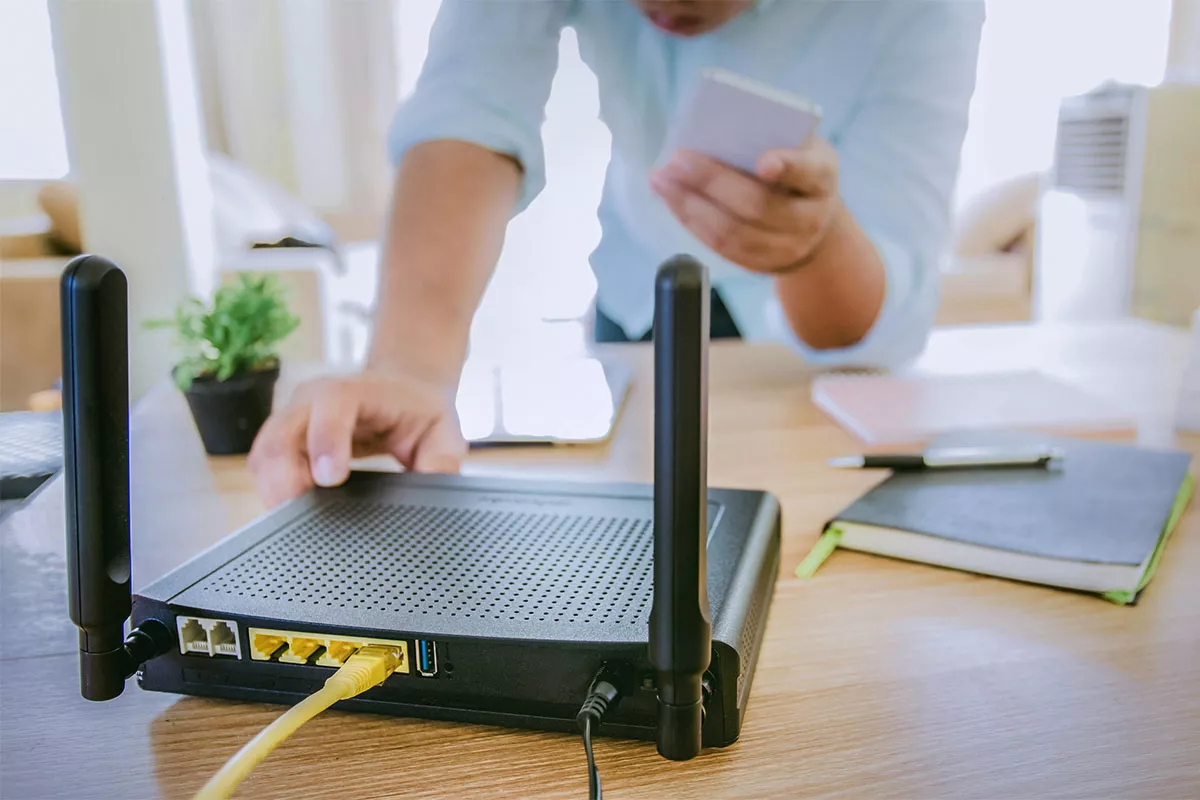

Are You Connected to Wi-Fi, But Have No Internet Connection? Here’s What To Do
Are you connected to Wi-Fi but have no internet connection?
It’s common for devices to show a Wi-Fi connection but still lack internet access. This can be frustrating, especially with the increasing need for remote work.
Whether it’s for work, school, or leisure activities, having a stable internet connection is essential. Below, we have gathered comprehensive troubleshooting steps to help you identify and fix these issues.
Understanding the Problem
What it means to be connected to Wi-Fi without internet access
When your device shows that it’s connected to a Wi-Fi network but you’re unable to access the internet, it signifies a common issue where the connection to the network is established, but there are obstacles preventing you from utilizing online features effectively.
Common causes of this issue include:
- ISP outages: Interruptions in your Internet Service Provider’s service can lead to temporary loss of connectivity despite being connected to Wi-Fi.
- Router/modem faults: Malfunctions in your router or modem hardware can hinder the transmission of data signals, causing an inability to access the internet.
- Incorrect network settings: Misconfigurations in network settings on your device or router can create barriers to internet access even when connected to Wi-Fi.
- Device-specific issues: Problems with your device’s software, driver compatibility, or hardware may also contribute to the inability to connect to the internet despite being linked to a Wi-Fi network.
Step-by-Step Troubleshooting Guide
Step 1: Reboot Modem and Router
When faced with the frustrating situation of being connected to Wi-Fi but having no internet access, one of the most effective initial steps is to reboot your modem and router. This process, also known as power cycling, can help resolve temporary glitches causing connectivity issues despite showing a Wi-Fi connection.
How to Reboot Modem and Router:
- Power Off: Begin by turning off both your modem and router. Locate the power cords on each device and safely unplug them from their power source.
- Wait: Allow a few minutes for the devices to completely power down. This waiting period is crucial to ensure that all residual power dissipates from the equipment.
- Power On: After waiting for a few minutes, plug in the modem first and wait for it to fully restart. Once the modem lights stabilize, proceed to plug in the router and allow it to reboot as well.
- Connection Check: Once both devices have restarted, check if your devices can now access the internet through the Wi-Fi connection.
By following these simple steps to reboot your modem and router, you may often find that this resolves connectivity issues and restores your internet access seamlessly.
Remember, this troubleshooting method is a quick and easy first step that can address common network problems. If you’re still facing issues after rebooting your devices, proceed to further troubleshooting steps outlined in this guide for a comprehensive resolution of your connectivity problems.
Step 2: Verify Router Settings and Permissions
When connected to Wi-Fi but lacking internet access, verify your router settings. Before diving into the router interface, confirm if the issue stems from your internet provider by checking outage status on independent sites like Down Detector or the Thousand Eyes Outages Map. Using cellular data to access these resources can quickly reveal if a wider ISP outage affects you.
Check Physical Connections
Physical connections also warrant inspection: ensure Ethernet cables are firmly plugged in and power supply to modem and router is stable. Testing internet connectivity via an Ethernet cable directly connected to your modem or router helps identify if the problem is Wi-Fi-specific.
Find Your Router’s IP Address
Accessing router settings requires knowing the default gateway IP address. On Windows, open Command Prompt and type:
- bash ipconfig
Look for the “Default Gateway” under your active network adapter. On macOS or Linux, use Terminal and enter:
- bash netstat -nr | grep default
Type this IP into a web browser to log into your router’s admin panel using your credentials.
Examine Router Settings
Inside the settings, examine MAC address filtering carefully. This feature restricts certain devices from accessing the internet based on their MAC addresses. If enabled, confirm your device’s MAC address is listed as allowed; otherwise, it may connect to Wi-Fi but be blocked from internet access.
Other permissions related to parental controls or firewall rules in the router interface can similarly impact connectivity for specific devices. Adjust these settings as needed for full internet access while maintaining security.
Step 3: Troubleshoot Device Network Settings and Software Conflicts
Devices sometimes show as connected to Wi-Fi but cannot access the internet due to outdated or incorrect network credentials. You should forget the Wi-Fi network on your device and then reconnect using the updated password. This clears any saved configurations that may prevent proper authentication.
Follow these steps depending on your device:
Windows/Mac:
- Navigate to your Wi-Fi settings, select the problematic network, and choose “Forget.” Reconnect by selecting the network again and entering the current password.
Mobile Devices:
- In Wi-Fi settings, tap the network name and select “Forget this Network.” Rejoin with the correct password.
VPNs and proxy servers can also block internet access even if Wi-Fi shows as connected. Disable any active VPN or proxy temporarily:
- On Windows, go to Settings > Network & Internet > VPN and disconnect.
- For proxy settings, navigate to Settings > Network & Internet > Proxy and turn off manual proxy setup.
Testing your internet connection via Ethernet cable helps isolate whether Wi-Fi is at fault. If Ethernet works but Wi-Fi doesn’t, focus troubleshooting on wireless settings.
Resetting network settings on Windows or Mac restores all network configurations to default, resolving deeper conflicts:
- On Windows, search for “Network Reset” in Settings under Network & Internet > Status.
- On Mac, use Terminal commands or system preferences for renewing DHCP leases.
These actions clear persistent software conflicts causing “connected to Wi-Fi but no internet” errors.
Step 4: Perform Network Reset on Windows Devices for Comprehensive Restoration
If the previous steps haven’t resolved your internet issues, you can try performing a network reset on your Windows device. This will restore all networking components to their default settings and may help fix any underlying problems.
Use Windows Network Troubleshooter
Windows has a built-in tool called the Network Troubleshooter that can automatically diagnose and repair common network issues. Here’s how to use it:
- Click on the Start button and select Settings (the gear icon).
- In the Settings window, click on Network & Internet.
- Depending on your connection type (Wi-Fi or Ethernet), select either Wi-Fi or Ethernet from the left sidebar.
- Scroll down and click on Network Troubleshooter under the Advanced section.
- Follow the on-screen instructions to complete the troubleshooting process.
Perform a Full Network Reset
If the Network Troubleshooter doesn’t resolve the issue, you can perform a full network reset. This will remove all network adapters and reinstall them, which can help fix more complex problems. Here’s how to do it:
- Click on the Start button and select Settings (the gear icon).
- In the Settings window, click on Network & Internet.
- Select Status from the left sidebar.
- Scroll down and click on Network Reset under Advanced network settings.
- Click on the Reset now button and confirm your action.
After performing a network reset, your computer will restart, and all networking components will be restored to their default settings. You may need to reconnect to your Wi-Fi network or reconfigure any custom network settings you had previously set up.
By using these built-in Windows tools, you can effectively diagnose and repair common network issues without requiring technical expertise.
Step 5: Scan for Malware and Temporarily Disable Security Software
Malware infections can disrupt network functionality, causing your device to show a Wi-Fi connection but block internet access. Running a full system scan using tools like Windows Defender or Malware Bytes helps detect and remove such threats.
Run a malware scan:
- Open Windows Defender or your preferred antivirus program.
- Select the option for a full system scan to check all files and processes.
- Follow the prompts to quarantine or delete any detected malware.
Security software such as firewalls or antivirus programs may mistakenly block legitimate network traffic. This interference can lead to “no internet connection” errors despite being connected to Wi-Fi.
Temporarily disable security software:
- Turn off your firewall and antivirus protection briefly.
- Test if the internet connection is restored during this period.
- If disabling resolves the problem, adjust settings or whitelist trusted networks and applications before re-enabling protection.
When To Contact Your Internet Service Provider or Seek Professional Help
If you’ve gone through all the troubleshooting steps and are still experiencing internet issues, it may be time to contact your ISP. Here are some signs that indicate you should reach out to them:
1. Problems Persist After Troubleshooting
If you’ve tried all the troubleshooting steps mentioned earlier in this guide and the problems still persist, it’s possible that there is an issue with your ISP’s service or your hardware.
2. Possible ISP Service Faults
Sometimes, the problem may lie with your ISP’s service itself. This could be due to maintenance work, outages, or other technical issues on their end. If you suspect this might be the case, contacting your ISP can help clarify the situation.
3. Hardware Malfunctions
In some cases, the issue could be with your modem or router. If you’ve ruled out all other possibilities and suspect a hardware malfunction, it’s best to get in touch with your ISP for assistance.
What Can Your ISP Do?
When you contact your ISP regarding internet issues, they have certain capabilities to help resolve the problem:
- Remote Reset: ISPs have the ability to remotely reset modems and routers. This can often fix connectivity issues caused by temporary glitches.
- Technician Dispatch: If the problem persists after a remote reset, your ISP may need to send a technician to inspect and repair or replace any faulty equipment.
It’s important to note that while ISPs can provide support for their services, they may not be able to troubleshoot issues specific to your network setup. In such cases, seeking professional help from a qualified technician may be necessary.
Enjoying Seamless Connectivity, All Day
Dealing with the frustrating scenario of no internet connectionrequires a proactive mindset. Complex network issues can demand professional assistance early on to avoid prolonged downtime.
Keep these points in mind for a reliable network setup:
- Act quickly when troubleshooting steps don’t restore connectivity
- Consult experts to identify hardware faults or ISP problems
- Maintain your equipment with regular updates and careful placement
A stable internet connection supports your work and business — protecting it ensures seamless productivity and peace of mind.
FAQs
Why am I connected to Wi-Fi but have no internet access?
Being connected to Wi-Fi without internet means your device is linked to the network but cannot access online services. Common causes include ISP outages, router or modem faults, incorrect network settings, or device-specific issues.
How can I troubleshoot when my Wi-Fi shows connected but there’s no internet?
Start by rebooting your modem and router to resolve temporary glitches. Then verify your ISP’s outage status using sites like Down Detector or Thousand Eyes Outages Map. Check router settings for MAC address filtering, inspect physical connections, and test connectivity via Ethernet cable to isolate the problem.
What steps should I take if my device connects to Wi-Fi but still can’t access the internet?
Forget and reconnect to the Wi-Fi network with updated credentials, disable VPNs or proxy servers that may interfere, reset network settings on your device, and perform a full network reset on Windows through Settings > Network & Internet > Status > Network Reset.
Could malware or security software cause Wi-Fi connection without internet issues?
Yes. Malware infections can disrupt network functionality. Running full system scans with Windows Defender or Malware Bytes helps detect threats. Temporarily disabling firewall or antivirus software can determine if they are blocking legitimate network traffic causing no internet errors.
When should I contact my Internet Service Provider (ISP) for help?
If all troubleshooting steps fail and issues persist, it may indicate ISP service faults or hardware malfunctions. ISPs can remotely reset equipment or dispatch technicians for repair or replacement to restore your internet connection.
How can I improve my Wi-Fi connectivity and avoid future no internet problems?
Position routers optimally avoiding obstacles like walls or metal objects that hinder signals. Consider using range extenders for larger coverage areas and upgrading routers if multiple devices exceed capacity limits.
Table of Contents









